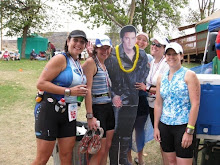Triathlete magazine
A triathlete's stride is critical to his or her running performance. Some athletes have a stride that eases across the ground with grace and composure while others appear to strain with every step.
However, if each component of the running action is carefully analyzed and developed, even the most ungainly runners can find improvement.
Stride Components
The stride consists of two parts: the stance phase, where the leg is in contact with the ground, and the flight phase, where the leg moves through the air and prepares for contact with the ground and the next stride.The stance phase: When a runner's foot hits the pavement, it is only in contact with the ground for about one-tenth of a second. In that short time, all of the mechanical forces that produce forward propulsion must be transferred through the leg. The powerful extension of the leg downward and backward creates the horizontal movement forward.
As Isaac Newton wrote in his laws of motion: for every action there is an equal and opposite reaction. So, the action of extending the leg backward creates a forward and upward movement (the flight phase).
The flight phase: As an athlete moves through the air, his leg swings backward and then moves rapidly forward. When the leading leg strikes, there can be a braking motion as speed is inhibited by the contact of the foot with the ground.
Athletes without efficient technique may be capable of generating substantial speed during the flight phase, but a jarring stance phase can hinder their forward progress. Overstriding is one of the key contributors to excessive braking during the stance phase.
Limb length, strength and running technique can affect stride length. Each athlete has an optimal stride length, so there is no one-size-fits-all rule; nonetheless, watch for excessive slapping of the feet on the pavement, and note that at most running speeds your right foot should strike the ground 21 times in 15 seconds.
Time yourself on your next run. If you are below 21 strikes for 15 seconds, you may be overstriding.
Doing it Right
Posture: Try to avoid exaggerated lean, either forward or back. Too much forward lean reduces the efficiency of the legs and can place strain on the hamstrings. Excessive backward lean can create muscular tension in the lower back and gluteal group, which can hasten fatigue and inhibit running efficiency.Instead, focus on running tall. An athlete with a slouched posture places restrictions on the limbs' ability to move freely. Still, despite the need for good running posture, stay loose—not rigid. A rigid posture leads to muscular tension that, in turn, inhibits performance.
Relaxation: After spending an hour or six on the aerobars, many triathletes hop off the bike with tight, bunched shoulders. And, as fatigue mounts, athletes frequently shrug their shoulders up into their necks, limiting their arms' ability to swing freely.
Build physical relaxation techniques into your training program and race-day regimen. Work at keeping your fingers, hands and jaw relaxed; no clenched fists, as this creates stiffness and tension. Emphasize the backswing with your arms and stay smooth and symmetrical.
Cadence: Cadence, or leg turnover, is one of the keys to running quickly. Harry Wilson, coach of four-time mile world record holder Steve Ovett, once said, "If you want to run fast, you have to keep your legs moving fast."
Triathletes are well known for their dedication to high-mileage training, and while this may improve their overall strength and conditioning, it can be at the expense of leg speed.
To retain your quickness during the season, include weekly short-repeat speed sessions on either the track or the road. During the early season, before you begin your specific race-preparation phase, include several sets of 15 seconds of quick legs during every run: You needn't go hard—just increase your leg turnover.
Trunk stability: Good core, or trunk, strength provides stability to the torso and limits inefficient body movements such as twisting.
As many of the muscles that generate movement originate in the core area, good conditioning can help an athlete produce speed and cope with race-day fatigue. This conditioning can be acquired through a number of activities, including Pilates and exercises such as crunches.
Rhythm: As noted above, athletes who run with an exaggerated stride length tend to be inefficient and tire quickly. However, understriding is also inefficient. An economic stride length tries to extract the maximum amount of return for the minimum amount of effort. To this end, work on keeping your hamstrings loose, as tightness can increase fatigue and enhance the perception of fatigue.
If you try the above tips and still don't see any improvement in your running, consider having a training partner videotape you. From the tape, you should be able to pinpoint areas of tension that can reduce running efficiency.
And while running performance may not be quite as closely correlated with good technique as an activity such as swimming, getting it right on the roads will allow you to run flat-out with economy at your next race.





















No comments:
Post a Comment